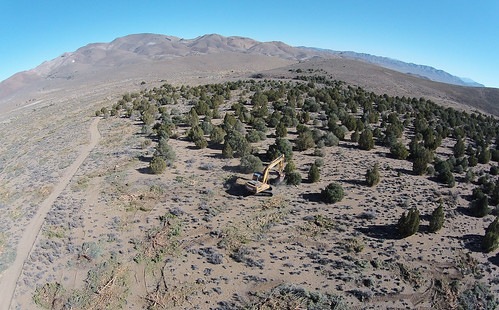
Bi-state sage-grouse, a geographically distinct population of small game bird that lives along the border of Nevada and California, rely on a healthy sagebrush ecosystem. One of the largest habitat threats to the sage-grouse is the encroachment of pinyon and juniper trees.
Once pinyon and juniper trees move into a sagebrush-steppe area, they act simultaneously like straws and umbrellas — sucking out what little water hits the soil, while providing a canopy to catch rainfall so little moisture reaches the plants and shrubs below the trees. Little by little, the trees can close in on an area, squeezing out precious habitat for the sage-grouse. They also deter sage-grouse from landing in the area, as the birds are frightful of these tall, foreign objects that interrupt their flight path and provide a perch for predators.
So, what’s the most viable solution for dealing with these ominous trees that may affect the future of the bi-state sage-grouse?
Enter the Bi-State Local Area Working Group (LAWG)—a forward-thinking group of people representing ranchers, agencies, conservation groups, private citizens and universities—who work across borders for the common good of sage-grouse. In 2012, this group released the Bi-State Action Plan which steers the Sage Grouse Initiative and other bi-state partner dollars where they are needed most: voluntary conservation easements that keep private ranchlands intact and other habitat improvement projects. Easements and invasive conifer removal are the top two conservation actions identified in the action plan.
In June 2014, Natural Resources Conservation Service Chief Jason Weller and Forest Service Chief Thomas Tidwell jointly submitted a USDA letter of assurance to the U.S. Fish and Wildlife Service committing to implementing the Bi-State Action Plan for Greater Sage Grouse and funding conservation actions to remove threats to the species. In addition to committing technical and financial resources, NRCS proposed a co-sponsored ‘Conifer Forum,’ where key ranchers, agency personnel, researchers and partners from Oregon and Idaho could share their demonstrated success tackling large-scale encroaching conifers across mixed ownerships with bi-state partners and landowners.
More than 165 stakeholders converged in Minden, Nev., in February for the high-profile forum aimed at solving a key conservation issue for bi-state sage-grouse: the expansion of pinyon and juniper forests into historic sagebrush-steppe. The purpose of the forum was to prioritize and implement large-scale projects through recently committed funding and collaboration between federal and state agencies, non-governmental organizations and private individuals.
“This forum plays a key role for the partners moving forward to carry out the historic commitment by NRCS, Forest Service and BLM,” Weller said. “I’m encouraged by such a great attendance and shared interest in strategically tackling this issue and formulating the best approaches possible. I’m confident as a team, we can all accomplish our conservation goals of restoring the sagebrush and securing the future of the bi-state sage-grouse.”
After a day and a half of productive workshops, the group headed to the field to see completed treatments in the area that are assuring sage-grouse have a home and the rangelands are as healthy as possible. With an army of stakeholders and partners engaged and dedicated to the effort, the future looks bright for the bi-state sage-grouse and the wildlife that share their range.
Since 2010, NRCS and its partners in the Sage Grouse Initiative have worked with private landowners to restore 4.4 million acres of habitat for sage-grouse while maintaining working landscapes across the West.
